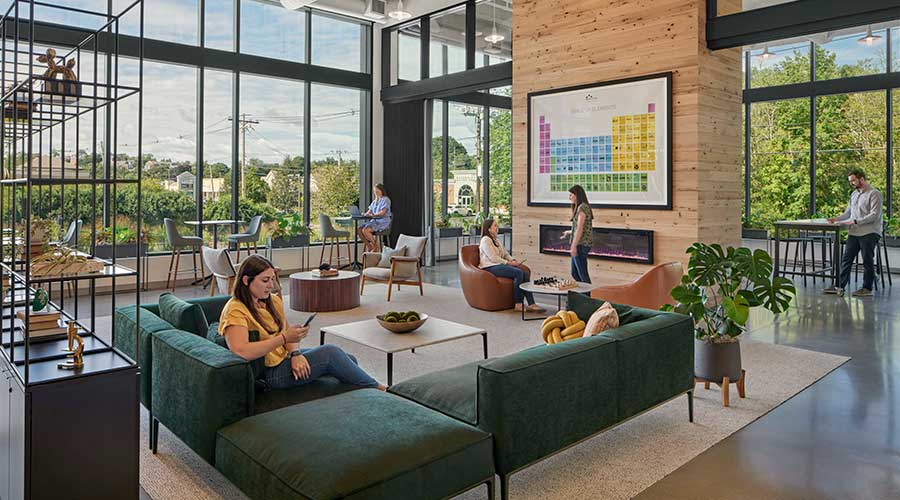Opening Minds to Open Offices
The move to an open office plan often provokes resistance. Careful planning can win over reluctant employees
Over the past several years many organizations have torn down physical walls and psychological barriers to transform how their employees work. The reason is clear: An open environment enables better communication that leads to innovation and more satisfied customers.
But figuring out how to achieve that goal can be dicey. Facility executives are still refining approaches for switching to open offices. Certainly it can be a difficult change for all involved.
Here are some tips for helping to ensure the success of this major transition:
- Know exactly why you want to move to open plan. Don’t make a move until you can clearly express to senior management and all levels of the workforce why it’s best for your organization.
- Make informed decisions about the specific aspects of open plan work environments you want to incorporate. From creating non-assigned seating plans to adding huddle rooms and cafes, options come in many flavors.
- Follow a thoughtful change management plan. A big part of moving from enclosed offices to open plan involves overcoming the workforce’s resistance to change.
Why an Open Plan?
There’s no doubt companies can cut occupancy costs by squeezing more people into less space in open plans. But there are often deeper, more strategic motives than simply cost savings.
Many companies want to motivate employees to work together by moving into collaborative, team-oriented environments. An open plan can help address problems related to isolation and siloing of information. Networked information exchange is a logical outcome when people engage their colleagues in corridor and workspace conversations.
Open plans with fewer hierarchical standards make a statement about a company’s “flat” culture. They also provide more flexibility. Instead of housing different levels of staff in spaces of 250, 200 or 150 square feet based on hierarchy, you can place them into smaller, interchangeable spaces designed to enhance function. This saves time and money because you won’t have to demolish and reconstruct an office when someone receives a promotion or transfers to a different team.
Open offices can also be the green choice. With energy conservation moved to the front burner these days, there is an explosion of interest in sustainable building design. Fewer private offices means fewer walls, simpler air handling systems, and less construction waste and materials. An open plan — particularly if you don’t place the remaining private offices along the windows — creates opportunities to bring daylight into the interior, reducing lighting and cooling loads.
For many organizations, the decision to move to open offices boils down to the simple idea that it’s just easier to have the right workspace in the right location at the right time for the right person.
Moving to Open Plan Offices
A key step in moving to open offices is developing a clear vision for the new open workplace by collaborating with senior management. Should the character of the open offices be inspiring, collaborative and energizing? Or is your culture better-suited for an environment that’s calmer and more contemplative? Maybe you want a little of each, with multiple settings where employees can move to different environments such as touchdown spaces or privacy rooms based on the work they’re doing.
You should evaluate employees’ specific jobs to decide if they’re suited for open plan. Do some groups have confidentiality or security issues? Do some require a high degree of privacy? It doesn’t make sense to put your software engineers, for example — people doing heads-down work that requires complex thinking — next to a copier or in a highly traveled corridor.
The best approach is one that asks employees for their input and involves them throughout the planning process. You can do this by holding employee meetings and using an electronic survey tool to inquire about their attitudes and desires for the workplace.
Truly assessing organizational readiness requires studying information about the current state of user group functions, a workforce demographics profile and attitudes, organizational history, business affinities and desired synergies. Incorporate the findings into the design of both the physical space and the change strategy.
Before Nissan North America moved its executive offices to an open plan setting to foster teamwork, strategic visioning sessions explored the company’s business goals and executives were interviewed about their work styles and workplace needs. All aspects of the company’s business functions were examined, including communications, work processes, work-life balance, reward and recognitions systems, compensation, and performance evaluations. Out of this study emerged a plan for a high-tech teaming environment that would enhance collaboration within the cross-cultural management team directing the company’s competitive repositioning.
For Warner Music’s move to a new open workplace in Toronto, key company stakeholders were tapped to help create a strategic plan to establish the project vision. The company established a “money well-spent” strategy focused on three priorities: improving team efficiency, creating a central square as the community hub for interacting, and telling a multimedia music story. Based on this vision, an open, community-based workplace was created that balances the opposing cultural and functional needs of heads-down business groups and “volume-up” music promotions teams.
Making the Change
Are you prepared to overcome the “Heck no, we won’t go!” mentality you’ll encounter? Employee resistance to major changes such as a move to open offices — where people may perceive they are losing something by being pulled out of a private office — is inevitable.
An effective change management program can help staff overcome their anxiety about a new way of working and, most importantly, get excited about your vision for improving their work lives. An experienced design consultant can help guide you through the steps. Make sure you’re working with an experienced team with a proven process — and that the chemistry between your two organization feels right.
Here’s a 10-step guide to an effective change management program:
- Make a quantitative case. Experience shows that it’s critical to gather hard data and make solid business case recommendations to management.
Outside design firms can have a tendency to emphasize values-based, Mom-and-apple-pie rationale such as “It’s just the right thing to do for people” or “It looks better.” That’s great, but when your boss looks you in the eye and asks, “Would you spend $50 million of your own money on a program like this?” you’d better have some hard data to support your recommendations. These days many employees are shareholders. Show them how many dollars per share of earnings this move to open offices could save in terms of occupancy cost decreases and productivity increases.
- Make a qualitative case. While the numbers are important, you also should factor in how work environments can improve the quality of work life, creativity, innovation, and recruiting and retention. It’s always a good thing when people enjoy being in their work environment.
- Communicate with employees. Articulate, publicize and socialize your vision for the space throughout the company. People fear the unknown. When they don’t hear anything, many will envision the worst possible scenarios. Make sure they understand the benefits and keep them involved throughout the transition. Tell them what’s going to happen, why it’s going to happen, when it’s going to happen and how it will affect them.
A change management communication program can include e-mails, newsletters, internal Web sites and Web-based and in-person “town hall” meetings.
For example, one organization needed a change management and communication strategy to help transition to 90 percent open plan. The first step was to identify barriers to change and concerns through user-representative focus groups, Web-based surveys and informal workplace observation. The findings were presented to workplace champions and corporate leaders. Once that group came to a consensus, the message was refined and kick-off meetings with workplace champions were scheduled at the appropriate locations. These were followed by town hall lunch events and pre-move orientation meetings with employees.
Newsletters and communiqués sent on a regular basis kept people informed. An open house allowed employees to tour their new workplace before move-in. Finally, post-occupancy surveys documented lessons learned and provided an opportunity to make minor adjustments going forward.
- Enroll a leader in the organization to champion the new open offices. Aim as high as possible up the organizational ladder. Former Intel Chairman and CEO Andy Grove used to sit in an 8-by-9 foot cubicle like the rest of his employees. And he didn’t do this to prove a point. He did it because he thought it was the most productive way to work.
- Give employees choices. People feel more empowered when they have input in the design of their new workstation. Give them options for personalizing the space in ways that support how they need to work and that help them feel at home.
- Create bonus features that don’t exist in your current workplace. Employees upset about losing a private office could feel better if they are gaining an amenity like a fitness center, war rooms, game tables or a coffee bar.
- Incorporate employee feedback. Furnishing workstation mock-ups and tours engage the workforce in designing their future workplace and build enthusiasm for the impending change. Build a workstation mockup and invite employees to see it, touch it and suggest improvements.
The work environment at Biogen Idec’s office and research campus in San Diego is 70 percent open plan and 30 percent enclosed offices. The company selected new systems furniture options for open plan workstations and offices organized a competition that included mockups by four manufacturers. The open plan workstations were designed to provide a high degree of privacy while also inviting collaboration. This vision was shared with employees through design presentations at various stages of the project.
- Train people how to use the new space. Don’t assume that everyone knows how to use each piece of furniture. Show them how to use the new systems with meetings, DVDs or online training.
- Develop a pilot project in which you test the open office concept on a floor or business group. Track the results of this pilot project and change your plan accordingly before rolling it to other groups.
- Conduct post-occupancy evaluations and make adjustments. Post-occupancy evaluations will help you gauge new business synergies, measure operational efficiencies and performance improvements, and generate lessons learned. Communicate to everybody the improvements you make over time.
Your organization may not have the time or resources to take all these steps. But, like any business process improvement effort, the more you involve your people in the process, the easier and more successful the transition will be.
HOMEWORK
Evaluating the Move To Open Offices
Rather than simply rubber stamping a major cultural change, the director of corporate real estate at one Fortune 500 company sought to ensure that a move to open offices was the best decision for the organization.
A quick workplace standards benchmarking study of related companies was undertaken. The study examined the ratios of open versus closed spaces and how effectively it was working for each. Company participants ranged from just 10 percent open all the way up to 95 percent open environments. Tours of a handful of sites helped company leaders observe open office environments in action.
The results of this research were presented to the company’s CEO, CFO and COO. The team also offered a high level evaluation of how the workplace can drive productivity, outlined the pros and cons of open versus closed space, and provided detailed case studies of a handful of companies. Based on this information, the company decided to go ahead with its move to an open environment.
The next step involved two beta tests of open environments designed in different parts of the country. Post-occupancy studies and interviews with management teams in each location helped set the future direction for the company-wide change to open offices.
|
Martha G. Rayle, FASID, IIDA is vice president of HOK Advance Strategies in Los Angeles. She has a long history of corporate strategy development in business, real estate and facilities. She has held senior corporate real estate positions in two Fortune 500 companies.
Related Topics:











